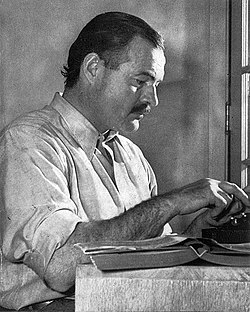2.5: Ernest Hemingway's "Hills Like White Elephants"
- Page ID
- 194023
Directions
Here, you will find the reading "Hills Like White Elephants" by Ernest Hemingway
The story is a docx. file. I recommend either printing it our or annotating the digital copy on your computer, or taking notes on the story on a separate piece of paper.
Author's Bio:
Ernest Hemingway was born and raised in Oak Park, Illinois, an affluent suburb of Chicago. His father, who was prone to depression and would later commit suicide, was a physician and his mother was a singer turned music teacher. Because Hemingway’s father was an avid outdoorsman, the family spent many of their summers in northern Michigan, which is where Hemingway set many of his short fiction, including the Nick Adams stories.
In 1917, Hemingway, at that time a writer for The Kansas City Star, was eager to join the Armed Forces to fight in the Great War (World War I) but was medically disqualified. Undiscouraged, he joined the ambulance corps and served on the Italian front. During shelling, Hemingway received a shrapnel injury but still carried a comrade to safety and was decorated as a hero.
When Hemingway returned to the States, living ultimately in Chicago, he fell under the mentorship of fellow modernist, Sherwood Anderson, who encouraged Hemingway to move to Paris. In 1920, Hemingway married Hadley Richardson; soon afterwards, the couple left for Paris. Surrounded by other writers of the period, such as Gertrude Stein, F. Scott Fitzgerald, Ezra Pound, Hemingway used these connections to help develop his own writing career. With F. Scott Fitzgerald’s help, Hemingway published his first novel The Sun Also Rises (1926) to great acclaim. The novel established Hemingway’s simplistic writing style while expressing the frustration that many felt about World War I. His second novel, A Farewell to Arms (1929), another critical success, once again, captured the disillusionment of the modernist period.
While Hemingway had a turbulent personal life, filled with divorces and failed relationships, he continued to write successful works including several collections of short fiction, for which he was well known, as well as novels and non-fiction. Some of his many works are Death in the Afternoon (1932), bringing bullfighting to a larger audience; To Have and Have Not (1937); and For Whom the Bell Tolls (1940), a classic novel on the Spanish Civil War. In 1952, Hemingway wrote what many consider to be his finest work, Old Man and the Sea, which was awarded the PulitzerPrize and led to his Nobel Prize for Literature in 1954. In 1961, after struggling with depression for years, Ernest Hemingway took his own life in Ketchum, Idaho.
While reading the story, keep these questions/ideas in mind:
- While reading this story, please pay close attention to the author's use of mystery or enigma.
- Do you see enigma being used?
- What kinds of enigma are being used?
- Does it enhance/detract from your enjoyment of the text?
- What about the story do you like?
- What about the story do you dislike?
- What is the iceberg in the story? What is above the surface? What is below?
- What do you think of the Girl and the American Man's Relationship?
- Why does the narrator use Girl and American Man, rather than names?
Essay Topic
As a reminder, your essay topic is: "Does the use of enigma enhance or detract from your enjoyment of a text?"
"Hills Like White Elephants" by E. Hemingway.doc
Video Lecture-"Hills Like White Elephants"-00:10:46
Berke, Bleil, & Cofer
Middle Georgia State University, College of Coastal Georgia, & Abraham Baldwin Agricultural College


